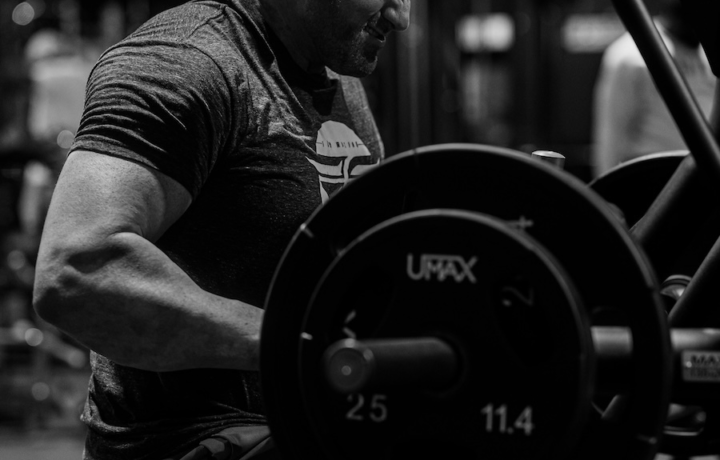Exercise
Lever Pec Deck Fly

Lever Pec Deck Fly
How to Perform
- Sit on the pec deck machine with your back firmly against the pad, feet flat on the floor, and adjust the seat height so the handles align with mid-chest level.
- Grasp the handles or place your forearms against the pads with elbows bent at approximately 90 degrees, maintaining a neutral wrist position.
- Pull your shoulders back and down, keeping your chest up and core engaged throughout the movement.
- Inhale deeply and prepare for the movement by ensuring proper posture and stability.
- Exhale as you slowly bring the handles or pads together in front of your chest, using your chest muscles to control the motion.
- Squeeze your chest muscles at the point of maximum contraction for 1-2 seconds, maintaining proper form without hunching forward.
- Inhale as you gradually allow the handles to return to the starting position with controlled resistance, keeping tension in your chest muscles.
- Maintain a consistent tempo throughout the set, avoiding jerky movements or allowing the weight stack to slam between repetitions.
Important information
- Make sure your elbows stay at shoulder height throughout the movement to maximize chest engagement and minimize shoulder strain.
- Keep your back pressed against the pad at all times to prevent arching and maintain proper form.
- Adjust the range of motion if you feel any shoulder discomfort, as forcing a complete stretch can stress the anterior shoulder.
- Focus on the contraction of your chest muscles rather than how much weight you're moving for optimal muscle development.

Lever Pec Deck Fly
Exercise Details
Primary Muscles
Muscle Groups
Mechanic
Risk Areas
Built for progress
Take the guesswork out of training
Create personalized AI-powered workout plans that evolve with you. Train smarter, track every rep and keep moving forward, one workout at a time.






The Lever Pec Deck Fly stands as a cornerstone chest isolation movement in the arsenal of intermediate bodybuilders and strength enthusiasts looking to sculpt and strengthen their pectoral muscles. This machine-based exercise effectively targets the entire chest region while minimizing shoulder strain that can sometimes occur with free-weight alternatives.
Unlike compound movements that engage multiple muscle groups, the Pec Deck Fly zones in specifically on the pectoralis major and minor, making it an excellent choice for those seeking detailed chest development. The controlled motion creates constant tension throughout the movement, stimulating muscle fibers across the entire chest wall for balanced development. This targeted approach makes it particularly valuable for bodybuilders working to address symmetry issues or lagging areas in their physique.
For intermediate lifters, the Lever Pec Deck offers a perfect blend of isolation and intensity. The machine's fixed movement pattern helps maintain proper form even as fatigue sets in, allowing for greater training volume without compromising safety. This makes it an ideal exercise to incorporate toward the middle or end of a chest-focused training session when stabilizing muscles may already be fatigued but you still want to push your pecs to their limit.
From a strength perspective, the machine allows for progressive overload in a controlled environment, letting you systematically increase resistance as your pectoral strength improves. While not typically used as a primary strength builder, its role in developing the supporting musculature of the chest contributes significantly to overall pressing power when paired with compound movements in a well-designed program.
Experienced bodybuilders often praise the mind-muscle connection that can be established with this exercise, as the isolated nature of the movement allows for intense focus on pectoral contraction. This heightened awareness can translate to improved engagement across all chest exercises, making the Lever Pec Deck Fly not just a physique enhancer but a valuable tool for developing the neuromuscular pathways essential for continued chest development.
FAQ - Lever Pec Deck Fly
The Lever Pec Deck Fly primarily targets the pectoralis major and minor (chest muscles). It also engages the anterior deltoids (front shoulders) and serratus anterior as secondary muscles during the movement.
Sit with your back flat against the pad, feet firmly on the floor, and adjust the seat height so your elbows and forearms align with the pads at shoulder level. Keep your elbows at a 90-degree angle throughout the movement and maintain a neutral spine position.
Include this exercise 1-2 times per week with at least 48 hours between sessions to allow for proper chest recovery. Position it in the middle or end of your chest workout after compound movements like bench presses for optimal muscle fiber recruitment.
Avoid using excessive weight that causes you to arch your back or shrug your shoulders. Don't rush through repetitions—maintain controlled movement with a deliberate squeeze at peak contraction. Never lock your elbows completely at the end range, which can place unnecessary stress on the joint.
The Lever Pec Deck Fly is generally safer for those with minor shoulder concerns compared to free-weight alternatives, as the fixed movement pattern reduces instability. However, consult with a healthcare professional before attempting if you have existing shoulder injuries, and always use a weight that allows for pain-free movement.






